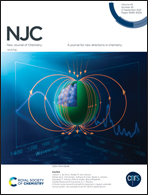Dimeric Mn(ii), Co(ii), Ni(ii) and Cu(ii) complexes of a common carboxylate-appended (2-pyridyl)alkylamine ligand: structure, magnetism and DFT study†
Abstract
Four new complexes of composition [MII2(L3)2(CH3OH)2](ClO4)2 (M = Mn, 1; Co, 2; Ni, 3) and [CuII2(L3)2](ClO4)2 (4) (L3(−) = 3-[2-(((6-methyl)pyridin-2-yl)methyl){(dimethylamino)ethyl}-amino]propionate) have been synthesized and characterized. Structural analysis reveals that 1–4 are discrete syn–anti carboxylate-bridged binuclear coordination complexes with a {MII2(–O–C–O–)2}2+ structural motif. In 1–3 distorted octahedral MN3O3 and in 4 distorted square pyramidal CuN3O2 coordination is satisfied at each M(II) center by three N (a pyridyl and two tertiary aliphatic amines) and a carboxylate O of the ligand, and an O of the carboxylate group. In 1–3 the M(II) center is also coordinated by a CH3OH molecule. Variable-temperature magnetic measurements reveal the presence of weak antiferromagnetic interactions in 1 and weak ferromagnetic interactions in 2–4. The electronic structure of 1–4 has been probed by density functional theory (DFT) calculations at the B3LYP level of theory. In order to gain insight into the origin of the observed electronic transitions, time-dependent (TD)-DFT calculations have been done.



 Please wait while we load your content...
Please wait while we load your content...